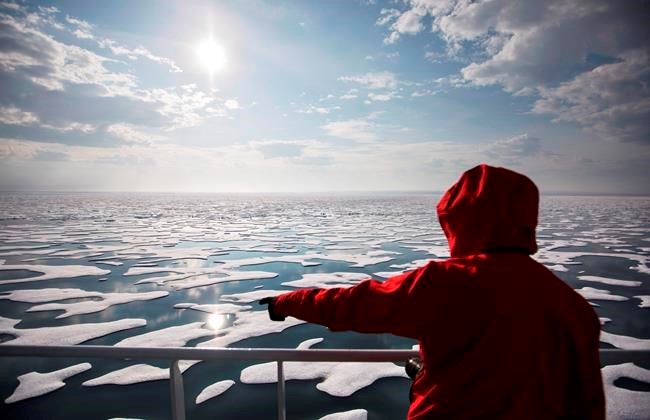MONTREAL — Michael Wenger still remembers the patches of blood red and vivid violet that daub the landscape of the Northwest Passage.
“People usually think it's ice and glaciers and rocks. And then you get there and you see these meadows, with all the different plants,” he said, speaking by phone from Reykjavik, Iceland, where he was attending an Arctic Circle Assembly conference.
“It’s very colourful,” said Wenger, CEO of Polar Journal AG, who worked as an expedition guide on a northern cruise vessel in 2016.
A growing number of people are now getting to witness those vibrant tundras first-hand. The same climate shifts that affect Arctic flora have also forced a massive retreat in Arctic sea ice — even in the passage, where geography and wind currents freeze the waters for a longer period of the year than in other parts of the Far North.
“It’s happening at a crazy rate,” said Bernard Funston, former chairman of the Canadian Polar Commission.
In step with the melt, more and more ships are sweeping across the Northwest Passage as a heating planet clears a path for boat traffic through the Arctic corridor, raising hopes for commercial viability as well as concerns about the environmental and social impact.
Steeped in lore since before Roald Amundsen became the first European to fully chart it in 1906, the Northwest Passage runs 1,450 kilometres from east to west, threading an archipelago of islands between Baffin Bay and the Beaufort Sea via a half-dozen routes under a single name. Effectively off-limits to transcontinental shipping for centuries, the seaway hosted a bulk freighter from end to end for the first time in 2013.
With a hull strengthened to withstand floating ice, the Nordic Orion that year hauled a load of metallurgical coal from Vancouver and across the Arctic coastline to Finland. The journey shaved 1,000 nautical miles from the traditional route through the Panama Canal and shipped 25 per cent more cargo due to the greater depth of the passage.
The ramp-up since has been striking, with bulk carriers, fuel tankers, cruise liners and research expeditions leading the charge.
The number of unique vessels operating in the Canadian Arctic rose 35 per cent to 212 between 2016 and 2022, according to figures provided by the international Arctic Council.
Researchers say the Northwest Passage will likely never compete with trade arteries like the Panama Canal due to the inconsistent navigation season, lack of ports and still-hazardous conditions.
But the diminishing ice, growth of northern resource development and more recently Russia’s invasion of Ukraine have already prompted more commercial vessels to travel the channels.
“The season is getting longer and the ships are getting bigger,” said Hjalti Hreinsson, a project manager at the Arctic Council. Cruise liners are among the largest vessels venturing through.
More ships carry the potential for more underwater noise, fuel pollution and invasive species, affecting communities and the environment in and around the passage.
“The biodiversity of the area is being directly threatened not merely by the passage of mega ships but by proposed seismic testing and other activities that would follow,” Peter Ittinuar, the first Inuk member of Parliament, said in a 2017 paper, referring to oil and gas exploration.
In Pond Inlet, locals told Wenger they used to hunt narwhal in a day or two. “Now they have to go out for five or six days before they even see a narwhal,” Wenger said. Noise-sensitive beluga and bowhead whales, essential to subsistence hunting traditions, also flee the sound of engines, while seals retreat in sync with the sea ice.
The anxieties of shippers and residents can overlap. If boats are stranded or an accident occurs, the tiny shoreline towns are ill-equipped to handle an influx of rescuees or transform into staging grounds for a cleanup effort.
In 2018, the Russian-flagged Akademik Ioffe research vessel ran aground in the passage’s Gulf of Boothia with 162 people on board, prompting rescue by a pair of Canadian Coast Guard icebreakers — and reflection on the perils of the waterway.
“The weather changes, it basically pushes ice right in front of the vessels and then they get caught,” said Wenger.
Several other deterrents remain before the Northwest Passage can become a full-blownhighway.
For massive container ships, parts of the route are too shallow and the passage offers no ports where the vessels can drop cargo, which they typically do at several points along a voyage.
“There’s a complete and utter lack of infrastructure. So it’s risky for companies to do this, and it’s not foolproof. Just because it’s shorter doesn’t mean it’s going to take less time,” said Jackie Dawson, the Canada Research Chair in the human and policy dimensions of climate change at the University of Ottawa.
“There’s just a lack of predictability. And if you do have an accident, there’s no one immediately there to help.”
Still, the numbers speak for themselves. “Even pleasure craft is going up really quickly,” Dawson said. “People are excited by the idea of traversing the Northwest Passage.
“In my world, a lot of scientists who would have wanted to work in Russia now want to work here,” she added, referring to that country’s attack on its neighbour. “We’re going to see more science vessels.”
The trend is already underway, with 13 research ships cruising arctic waters in Canada last year versus four in 2016, according to the Arctic Council group.
For Wenger, the call of the wild animals — polar bears, seals, muskox — he saw in the passage persists. But other images remain even more frozen in his mind.
“Seeing an area that had been dubbed one of the hardest waterways to cross due to the ice conditions ... without any ice — that was a real wow,” he recalled. “I didn't expect that.”
This report by The Canadian Press was first published Nov. 5, 2023.
Christopher Reynolds, The Canadian Press



